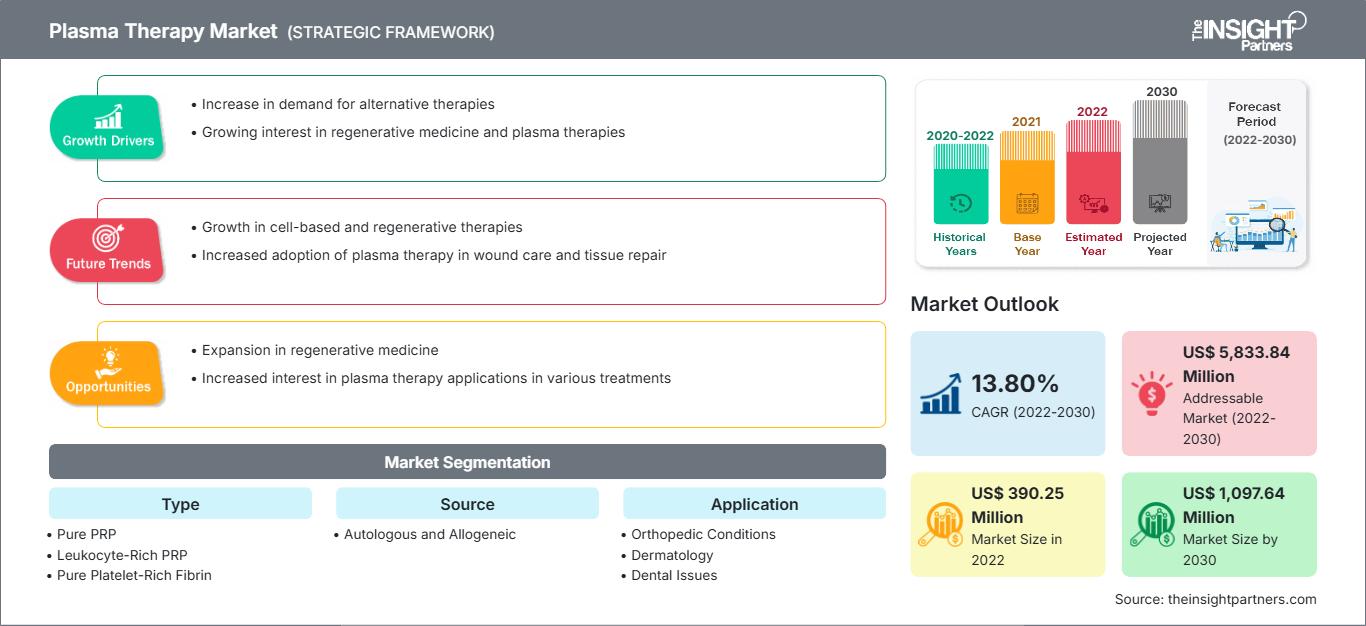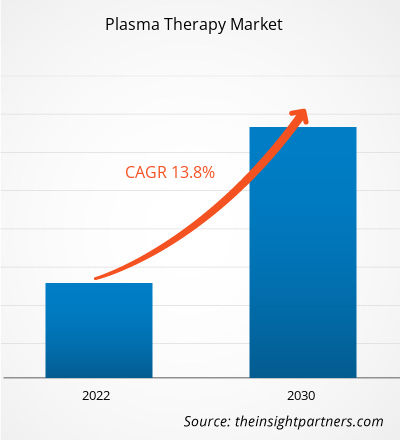[Forschungsbericht] Der Markt für Plasmatherapie wird voraussichtlich von 390,25 Millionen US-Dollar im Jahr 2022 auf 1.097,64 Millionen US-Dollar im Jahr 2030 wachsen; der Markt wird voraussichtlich zwischen 2022 und 2030 eine durchschnittliche jährliche Wachstumsrate (CAGR) von 13,80 % verzeichnen.
Sichtweise des Analysten
Die Marktanalyse für Plasmatherapie erläutert Wachstumstreiber wie die steigende Zahl orthopädischer Erkrankungen bei Menschen, insbesondere bei älteren Menschen, die steigende Zahl von Gelenk- und Muskelverletzungen bei Sportlern und die steigende Nachfrage nach minimalinvasiven kosmetischen Eingriffen. Darüber hinaus ist die individuelle Anpassung der Plasmatherapien an die Bedürfnisse der Patienten von entscheidender Bedeutung. Es wird erwartet, dass der Bedarf zwischen 2022 und 2030 neue Trends auf dem Markt hervorbringen wird.
Die Plasmatherapie, auch als plättchenreiches Plasma (PRP) bezeichnet, beinhaltet die Verwendung des Blutplasmas von Personen, die sich erfolgreich von einer Krankheit erholt haben, um verschiedene medizinische Beschwerden zu behandeln und den Heilungsprozess zu fördern. PRP-Behandlungen finden Anwendung in der Orthopädie zur Behandlung von Gelenkverletzungen, in der Dermatologie bei Hautverjüngungsverfahren und in der Zahnmedizin zur Gewebereparatur. Die im PRP enthaltenen Wachstumsfaktoren stimulieren effektiv die Regeneration von Gewebe und beschleunigen so die Heilung von Verletzungen oder verbessern die Mechanismen ästhetischer Verfahren.
Markteinblicke
Steigende Fälle von orthopädischen Erkrankungen und Muskelverletzungen und zunehmender Einsatz von PRP bei ästhetischen Eingriffen beflügeln den Markt für Plasmatherapie
Laut Statistiken der Weltgesundheitsorganisation (WHO) aus dem Jahr 2023 lebten im Jahr 2019 weltweit etwa 528 Millionen Menschen mit Osteoarthritis (OA), was einem Anstieg von 113 % seit 1990 entspricht. Ein im Dezember 2020 in PubMed Central veröffentlichter Artikel besagt, dass die Verwendung von PRP aufgrund der Fülle an Wachstumsfaktoren und Zytokinen in diesem Plasma, die für die Initiierung und Modulation regenerativer Mikroumgebungen für Weich- und Hartgewebe von entscheidender Bedeutung sind, Potenzial für die Gewebereparatur bietet. Die PRP-Therapie kann zur Heilung von Knochenbrüchen, Bänder-, Muskel- und Sehnenverletzungen, Verletzungen peripherer Nerven, Gelenkknorpelschäden und Osteoarthritis eingesetzt werden. Daher besteht eine hohe Nachfrage nach Plasmatherapien in der Orthopädie und bei Gewebereparaturverfahren.
Darüber hinaus wird PRP in der Schönheitschirurgie zur Hautverjüngung, Anti-Aging und anderen ästhetischen Verfahren eingesetzt. Von 73 Studien, die in einer im November 2021 in PubMed Central veröffentlichten Übersichtsarbeit ausgewertet wurden, konzentrierten sich 45 auf die PRP-Monotherapie, während 35 Studien die Wirkung von PRP in Kombination mit Microneedling untersuchten. Infolgedessen waren die Therapien gut verträglich und für alle Phototypen geeignet. Positive Behandlungsergebnisse wurden für verschiedene Erkrankungen festgestellt, darunter Hautverjüngung, Narbenkorrektur, Alopezie, Pigmentstörungen, Lichen sclerosus, leprabedingte periphere Neuropathie, Plaque-Psoriasis und Nagelerkrankungen.
Daher trägt der Einsatz von PRP in der Schönheitschirurgie zum Wachstum des Plasmatherapiemarktes bei.
Zukünftiger Trend
Anpassungsoptionen zur Einführung patientenzentrierter Therapien zeichnen sich als zukünftiger Trend im Plasmatherapiemarkt ab
Angepasste Plasmatherapie bedeutet die Personalisierung von Plasmatherapien, um die Bedürfnisse der Patienten basierend auf Faktoren wie ihren spezifischen Erkrankungen und ihrer genetischen Veranlagung zu erfüllen. Die Anpassungsbemühungen konzentrieren sich auf die Verbesserung der Wirksamkeit der Plasmatherapie durch Anpassung der Zusammensetzung von Komponenten wie Antikörpern und Proteinen, um den spezifischen Gesundheitszustand des Patienten wirksamer zu behandeln. Forscher und medizinisches Fachpersonal nutzen ihr Fachwissen, um die Plasmatherapie auf spezifische Erkrankungen wie Autoimmunerkrankungen, Infektionskrankheiten und seltene Krebsarten abzustimmen. Unternehmen wie Regenexx und Bridging Biosciences bieten hochreines und konzentriertes PRP an, das individuell angepasst werden kann, um Inkonsistenzen bei der Heilung von Gewebeschäden und der Zellregeneration zu vermeiden. Das USA Medical Research Institute in Texas bietet die PRP TruDose-Therapie an, die personalisierte therapeutische Dosen zur Behandlung verschiedener chronischer Schmerzen bei Erkrankungen des Bewegungsapparats, LUPUS, Nahrungsmittelunverträglichkeiten, Lyme-Borreliose und vielen degenerativen Erkrankungen enthält.
Passen Sie diesen Bericht Ihren Anforderungen an
Sie erhalten kostenlos Anpassungen an jedem Bericht, einschließlich Teilen dieses Berichts oder einer Analyse auf Länderebene, eines Excel-Datenpakets sowie tolle Angebote und Rabatte für Start-ups und Universitäten.
Markt für Plasmatherapie: Strategische Einblicke

-
Holen Sie sich die wichtigsten Markttrends aus diesem Bericht.Dieses KOSTENLOSE Beispiel umfasst Datenanalysen, die von Markttrends bis hin zu Schätzungen und Prognosen reichen.
Berichtssegmentierung und -umfang
Typbasierte Erkenntnisse
Basierend auf dem Typ ist der Plasmatherapiemarkt in reines PRP, leukozytenreiches PRP, reines plättchenreiches Fibrin und leukozytenreiches Fibrin segmentiert. Das Segment reines plättchenreiches Fibrin hatte 2022 den größten Marktanteil und wird voraussichtlich zwischen 2022 und 2030 die höchste durchschnittliche jährliche Wachstumsrate (CAGR) verzeichnen. Leukozytenreiches PRP (LR-PRP) ist ein PRP-Typ, der eine höhere Konzentration an Neutrophilen (weißen Blutkörperchen) als der Ausgangswert aufweist. Es wird im Allgemeinen mit entzündungsfördernden Wirkungen in Verbindung gebracht. In einigen Fällen kann LR-PRP jedoch hilfreich sein, um Entzündungen im Körper zu stimulieren und so auf eine chronische Erkrankung wie eine Tendinopathie hinzuweisen.
Quellenbasierte Erkenntnisse
Der Markt für Plasmatherapie ist nach Quelle in autologe und allogene Therapie unterteilt. Das autologe Segment dominierte den Markt im Jahr 2020.
Anwendungsbasierte Erkenntnisse
Der Markt für Plasmatherapie ist nach Anwendung in orthopädische Erkrankungen, Dermatologie, Zahnprobleme und Sonstiges unterteilt. Das Segment Dermatologie hatte im Jahr 2022 den größten Marktanteil.
Endnutzerbasierte Erkenntnisse
In Bezug auf die Endnutzer wird der Markt für Plasmatherapie in Krankenhäuser und Kliniken, Forschungsinstitute, ambulante chirurgische Zentren (ASCs) und Sonstiges unterteilt. Das Krankenhaussegment hatte im Jahr 2022 den größten Marktanteil und wird voraussichtlich zwischen 2022 und 2030 die höchste durchschnittliche jährliche Wachstumsrate (CAGR) auf dem Markt verzeichnen.
Plasmatherapie
Regionale Einblicke in den PlasmatherapiemarktDie Analysten von The Insight Partners haben die regionalen Trends und Faktoren, die den Plasmatherapiemarkt im Prognosezeitraum beeinflussen, ausführlich erläutert. In diesem Abschnitt werden auch die Marktsegmente und die geografische Lage in Nordamerika, Europa, dem asiatisch-pazifischen Raum, dem Nahen Osten und Afrika sowie Süd- und Mittelamerika erörtert.
Umfang des Marktberichts zur Plasmatherapie
| Berichtsattribut | Einzelheiten |
|---|---|
| Marktgröße in 2022 | US$ 390.25 Million |
| Marktgröße nach 2030 | US$ 1,097.64 Million |
| Globale CAGR (2022 - 2030) | 13.80% |
| Historische Daten | 2020-2022 |
| Prognosezeitraum | 2022-2030 |
| Abgedeckte Segmente |
By Typ
|
| Abgedeckte Regionen und Länder |
Nordamerika
|
| Marktführer und wichtige Unternehmensprofile |
|
Dichte der Marktteilnehmer im Bereich Plasmatherapie: Auswirkungen auf die Geschäftsdynamik verstehen
Der Markt für Plasmatherapie wächst rasant. Die steigende Nachfrage der Endverbraucher ist auf Faktoren wie veränderte Verbraucherpräferenzen, technologische Fortschritte und ein stärkeres Bewusstsein für die Produktvorteile zurückzuführen. Mit der steigenden Nachfrage erweitern Unternehmen ihr Angebot, entwickeln Innovationen, um den Bedürfnissen der Verbraucher gerecht zu werden, und nutzen neue Trends, was das Marktwachstum weiter ankurbelt.

- Holen Sie sich die Markt für Plasmatherapie Übersicht der wichtigsten Akteure
Regionale Analyse
Nordamerika dominierte den Plasmatherapiemarkt im Jahr 2022. Darüber hinaus wird erwartet, dass zwischen 2022 und 2030 die höchste durchschnittliche jährliche Wachstumsrate (CAGR) auf dem Markt verzeichnet wird. Der nordamerikanische Markt ist in die USA, Kanada und Mexiko segmentiert. Die USA halten den größten Marktanteil am globalen Plasmatherapiemarkt. Das Marktwachstum des Landes wird der zunehmenden Verwendung von plättchenreichem Plasma (PRP) in der orthopädischen und kosmetischen Chirurgie, steigenden Investitionen im Gesundheitssektor, der dynamischen Forschungs- und Entwicklungslandschaft und der Zulassung ausgewählter PRP-Therapien durch die USFDA zugeschrieben.
Der Bericht porträtiert führende Akteure auf dem globalen Plasmatherapiemarkt. Dazu gehören BioLife Plasma Services; Takeda Pharmaceutical Company Limited; Biotest AG CSL Ltd.; Grifols, SA; Kedrion SpA; ImmunoTek Bio Centers; Bio Products Laboratory Ltd.; China Biologic Products Holdings, Inc.; Octapharma AG; und Origin, Inc. Diese führenden Akteure konzentrieren sich auf die Ausweitung und Diversifizierung ihrer Marktpräsenz und ihres Kundenstamms und nutzen so bestehende Geschäftsmöglichkeiten.
Wichtige Entwicklungen der wichtigsten Marktteilnehmer sind:
- Im März 2023 gab BioLife Plasma Services die Eröffnung seines Plasmaspendezentrums in den USA mit neuen Standorten in West Springfield (Massachusetts) und Pearland (Texas) bekannt. Diese Expansion würde dem Unternehmen helfen, sein Geschäftsnetzwerk zu erweitern.
- Im Februar 2021 brachte die Atlas Health Medical Group den SkinPen auf den Markt. Dieses kleine stiftförmige Mikronadelgerät mit PRP für Facelifts punktiert die Haut und stimuliert eine Anti-Aging-Reaktion.
- Im März 2020 begann Takeda Pharmaceutical Company Limited mit der Entwicklung eines polyklonalen Hyperimmunglobulins (H-Ig) gegen SARS-CoV-2 zur Behandlung von Personen mit schwerem COVID-19-Verlauf.
- Historische Analyse (2 Jahre), Basisjahr, Prognose (7 Jahre) mit CAGR
- PEST- und SWOT-Analyse
- Marktgröße Wert/Volumen – Global, Regional, Land
- Branchen- und Wettbewerbslandschaft
- Excel-Datensatz
Aktuelle Berichte
Erfahrungsberichte
Grund zum Kauf
- Fundierte Entscheidungsfindung
- Marktdynamik verstehen
- Wettbewerbsanalyse
- Kundeneinblicke
- Marktprognosen
- Risikominimierung
- Strategische Planung
- Investitionsbegründung
- Identifizierung neuer Märkte
- Verbesserung von Marketingstrategien
- Steigerung der Betriebseffizienz
- Anpassung an regulatorische Trends






















 Kostenlose Probe anfordern für - Markt für Plasmatherapie
Kostenlose Probe anfordern für - Markt für Plasmatherapie